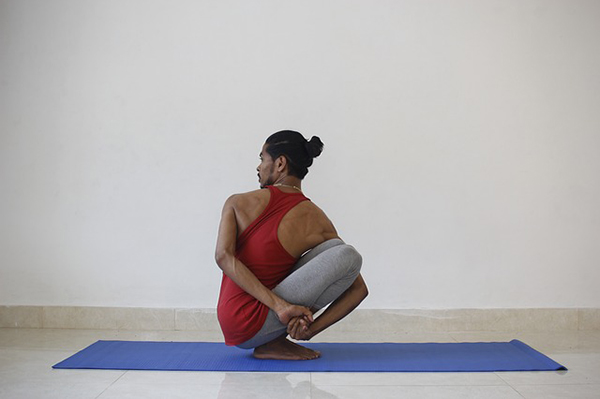Pear, Gorgonzola & Cranberry Salad
This beautiful salad goes well with any holiday meal with the sweet taste of cranberries and the bold taste of Gorgonzola cheese.
Recipe: Transformed green bean casserole
If you want something different for your Thanksgiving table this year, try this new rendition of the traditional green bean casserole from Cooking Light. It provides a healthy serving of vegetables with less saturated fat and sodium than its classic counterpart.
Nutrition: Healthy holiday hacks
 Healthy eating during the holidays is not about deprivation, but about all things in moderation. We have some tips to help you put this crucial concept to work for you in the coming months.
Healthy eating during the holidays is not about deprivation, but about all things in moderation. We have some tips to help you put this crucial concept to work for you in the coming months.
Stay one step ahead when you’re head chef.
1) Delegate! 2) Shop early! 3) Prepare! Hosting doesn’t mean you have to do everything. Ask guests to bring whole-grain bread, a vegetable side, or a selection of no-sugar beverages. Next, study the recipes you have planned, and buy as many ingredients ahead of time as possible—like canned and frozen items and hardy vegetables like squash and carrots. Finally, one day ahead of the big meal, chop and peel vegetables, and make items like cranberry sauce and dessert.
Eat before you eat.
Dietitians swear by this hack! Heading to a holiday gathering? If you show up hungry, there’s a good chance you’ll overeat or fill up on high-fat appetizers. So before you head to auntie’s famous holiday potluck, eat a small, healthy snack like cheese on whole-wheat crackers or hummus with celery or tortilla chips. Take the edge off your hunger so you have more control at the party.
Contribute a healthy, savory dish.
If you’re heading to a shared meal, offer to bring a savory, nutritious dish. This way, you know for sure that your healthy eating habits won’t be forced to take a holiday! Explore interesting vegetable dishes, like this salad with roasted apples, squash and feta cheese. Keep it simple and use a bottled vinaigrette. Or maybe try fried rice with cauliflower. You might find a bag of cauliflower “rice” in the produce aisle.
Freeze the extras.
If you have lots of leftovers and are concerned about waste or overeating, try freezing them! Place cold portions in baggies, label them with name and date, and freeze. Leftover turkey, sweet potatoes and even mashed potatoes are healthy snacks—or interesting additions to new recipes. Explore ideas for leftover sweet potatoes. Or, as one foodie touts, “The Happiest Ending for Leftovers Is Quiche.” (Keep a frozen pie shell on hand!)
Diabetes diagnosis? Take time to learn
An estimated 1.4 million new cases of diabetes are diagnosed in the United States annually, according to Healthline. With such staggering statistics, the importance of spreading awareness can help individuals with diabetes live full and productive lives, and in some cases, can help to prevent the onset of diabetes altogether. Here to provide a wealth of information on the topic is Pacific Medical Centers’ Internist and Diabetes Champion Lisa Oswald, MD, whose insight provides perspective on diabetic symptoms, care techniques, and the differences of Type I and Type II diabetes.
Please explain the primary differences between Type I and Type II diabetes for our readers. What are the main causes of each?
Type 1 diabetes (five percent of patients) has onset in childhood or sometime in early-mid adulthood. It is caused by a loss of the insulin-producing part of the pancreas. It may be caused by the body attacking itself or may have other causes.
Type 2 diabetes (90-95 percent of patients with diabetes have this type) is caused by the body not being able to use the insulin that our body produces very well (this is called “insulin resistance”). Eventually, there may be a lack of insulin, but normally there is plenty of naturally produced insulin that the body just can’t use properly. The causes are complicated, but genetics, being overweight, poor diet, and sometimes medications or medical conditions can all be factors of developing Type 2 diabetes.
What are some early signs and symptoms that may be indicators of diabetes?
Signs and symptoms of diabetes may include excessive thirst or urination; blurry vision; tingling in toes and/or fingers, usually of both sides; unexplained weight loss (especially in Type 1); and unexplained abdominal pain.
What advice can you offer individuals with diabetes to live the healthiest and happiest life possible?
My advice to those who are living with diabetes is to try and educate yourself as much as possible. Diabetes is a complicated and lifelong disease and you must be aware of many aspects of it. This can include talking to family/friends, taking classes (PacMed offers a series of three classes every month), reading about the topic, talking to your primary care doctor and nurse and certified diabetes educators. Additionally, you should have support to get you through this. This can include supportive people in your life, online group, medical team, etc. Lastly, it helps to know about your insurance. Sometimes diabetes medications are expensive, but you should know your options. Be sure to ask your pharmacist or primary care provider about the cost of different medications and if there are cheaper alternatives.
Military personnel are constantly on the go. What are the best practices for diabetics who are very busy?
My advice to military personnel would be to explain your average day to your primary care team and diabetes educator — be realistic about schedules for eating and taking medications. I also encourage making plans with your primary care team for days that you cannot eat for long periods or take medications at the proper time, as this will happen on occasion.
Is there anything else you would like readers to know about diabetic health and wellness?
Additional health and wellness tips I have for those who have diabetes are centered around routine lifestyle changes. Schedule a routine hour or two per week to prepare food and snacks for the upcoming week that you can grab and take with you — it doesn’t have to be perfect! Exercise is also important, so try to make time in your day to be active. This can include short bursts of activity, such as walking, taking the stairs, dancing, playing with children, etc.
Lisa Oswald, MD works on the Internal Medicine team at Pacific Medical Centers. She is an internist and focuses on diabetes with her patients at the Beacon Hill clinic. Her medical interest is within geriatrics, end-of-life care and cross-cultural medicine. In her spare time, you can find her rowing, traveling and spending time with her family. She has been named one of Seattle’s best doctors by her peers for the last five years.
Winter blues got you down—again?
 If you always experience depression that begins in fall and continues to spring, don’t brush it off as simply a case of the “winter blues.” You may suffer from Seasonal Affective Disorder (SAD). You don’t need to tough it out on your own! We have supportive help and steps you can take to keep your mood and motivation steady all year long.
If you always experience depression that begins in fall and continues to spring, don’t brush it off as simply a case of the “winter blues.” You may suffer from Seasonal Affective Disorder (SAD). You don’t need to tough it out on your own! We have supportive help and steps you can take to keep your mood and motivation steady all year long.
Depression and SAD
Depression is a common and treatable condition that can affect anyone. Like other types of depression, SAD is a condition of the brain that leaves a person feeling down. It can sap your energy, erase your motivation and make you moody.
Symptoms specific to wintertime SAD include oversleeping, craving foods high in carbohydrates, weight gain and low energy. Other general signs of depression can include:
- No longer enjoying the things you usually like to do
- Feeling sad, down, hopeless or cranky most of the day, almost every day
- Experiencing changes in your appetite, weight and sleep patterns
- Feeling tired or having no energy
- Having trouble concentrating
- Feeling agitated
- Thinking about death or suicide
Coping and treatments
Ongoing depression is never a normal part of life. We have safe and effective treatments to help you cope. These include seeing a psychotherapist, taking medications or a combination. With SAD, light therapy can also be a powerful treatment protocol. Read on for light therapy and other ideas you can discuss with your doctors.
Light therapy. With light therapy (also called phototherapy), you expose yourself to a special light box right after you wake up each day. Doing this appears to trigger a change in your brain chemistry and boost your mood. It’s a bit like getting some summer sunshine to start the day. Light therapy often offers relief from SAD in just a few days.
Vitamin D. Our bodies naturally synthesize vitamin D when exposed to sunlight. All you need for a week’s worth of this vitamin is 15 to 20 minutes in the sun—but that can be hard to come by during winter in the Northwest. Because vitamin D helps the body absorb calcium, it supports healthy bones. But recent research has also shown it may help alleviate symptoms of SAD.
Exercise. Physical activity is helpful for all types of depression because it increases the production of endorphins in the body. Endorphins are neurotransmitters that make you feel good.
Sleep. Sleep is a very important way to lessen symptoms. Good sleep hygiene includes getting up at the same time every day, following a bedtime routine to program your body to sleep and keeping your room dark at night. Also avoid all screen use for at least 30 minutes before bedtime.
When to get help
It’s normal to have some days when you feel down. But if you feel down for days at a time and you can’t get motivated to do activities you normally enjoy, see your doctor. This is especially important if you notice some of the symptoms listed above, you turn to alcohol for comfort or relaxation, or you feel hopeless or think about suicide.
With all types of depression, your primary care provider can help guide you to the support you need. Looking for a doctor? See our primary care team at one of our 9 PacMed clinics
ARE YOU OR SOMEONE YOU KNOW IN CRISIS?
If you are thinking about suicide or hurting yourself, help is available:
- In an emergency, call 9-1-1 or go to the nearest ER
- Call a 24-hour crisis line:
King: 1.866.427.4747
Snohomish: 1.800.584.3578
Pierce: 1.800.576.7764 - Call the National Suicide Prevention Lifeline: 1 (800) 273-8255
Stay Energized This Winter!
 Between short days, cool weather, holidays and visiting family, it is easy to feel dragged down. Make yourself a top priority! Explore these ideas on how to keep your energy up and fuel your best health.
Between short days, cool weather, holidays and visiting family, it is easy to feel dragged down. Make yourself a top priority! Explore these ideas on how to keep your energy up and fuel your best health.
Work it out. Physical activity boosts your brain chemistry, helps you sleep and primes your appetite for healthy eating! This winter, find ways to keep your exercise goals alive. Get up a little earlier to slip in a run. Walk to work, or climb stairs or hills at lunchtime. Meet a friend at the gym. Maybe you can help an elderly neighbor by raking their yard! Choose a weekly goal—say, 75 minutes of vigorous exercise or 150 minutes of moderate exercise—and then track your time and reward your success.
Lap it up! If you are not well hydrated, one of the first signs is fatigue. Water makes up about 60% of your body weight and is the main component of blood. It’s essential for carrying nutrients to your cells and removing waste products. So, how much should you drink? Watch the color of your urine. It should be a light lemonade color. Dark yellow? Drink a little more. And to keep up energy when you work out, drink 8 ounces of water before you begin, and another glass when you finish.
Don’t run on empty! Did you know that a smaller lunch can help you keep your energy up? A heavy lunch is often followed by a pronounced afternoon slump. Another energizing trick is to eat small meals and snacks every few hours. This can reduce feelings of fatigue because your brain needs a steady supply of nutrients. So what to snack on? Try protein- and magnesium-packed nuts like cashews, almonds and hazelnuts. Eggs and edamame have protein plus vitamin B, which helps convert food into the energy you feel. Finally, eat fresh fruit for a healthy source of fiber, vitamins, sugar and fluids!
Recharge at night. When you get enough sleep, you should feel refreshed in the morning and energized throughout the day. Sleep pretty much affects everything in your life: your heart health, metabolism, ability to ward off sickness and more. Not getting enough good-quality sleep can affect short-term memory, decision making, attention levels, logical reasoning, judgement, mood, and energy levels. Three good tips for healthy sleep hygiene? Go to bed and get up at the same time each day. Avoid all screens 90 minutes before you head to sleep. And slow your pace before bedtime: read a calm book, listen to quiet music or meditate.
Got a cold or the flu? Symptoms for both cold and flu include coughing, headaches and chest discomfort. When you have a cold, your nose and throat become inflamed, so you may experience a runny nose, sore throat, coughing and sneezing. Flu symptoms come on much more suddenly than with a cold, including a high fever, body aches, weakness and fatigue. Sleep, frequent hydration, daytime rest and good nutrition are important. Most over-the-counter medications can help temporarily relieve symptoms such as sore throat, congestion, cough and fever. If your symptoms persist or you have questions about which medications to take, consult your primary care provider.
PacMed Primary Care is a diverse team of providers! If you’re looking for a doctor to support your health goals, we invite you to learn more about our doctors.








